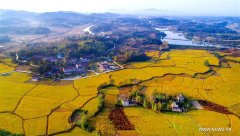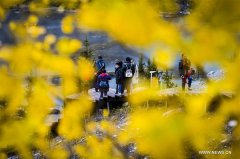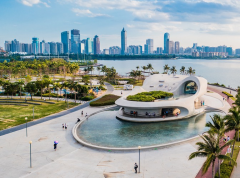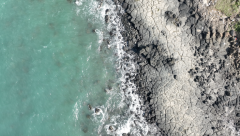16 Hainan Coastal Scenic Highway Viewing Platforms Completed
The Hainan Coastal Scenic Highway, China's No. 1 national coastal scenic avenue that runs through all 12 of the province's coastal cities and counties, is set to fully open to traffic by the end of December.
Currently, 40 "destination stations" that bring together local geography, history, culture, and customs have been planned along the route. In addition, 70 rest stops and viewing platforms are in the works, with 16 viewing platforms now complete.

The coast by Leigong Islet in Chengmai. (Photo: Wang Xiaochang)
The viewing platforms along the highway serve as an extension of the route itself, enabling tourists traveling along the route to get out of their cars and more fully immerse themselves in the beauty of Hainan's natural scenery and experience local history and culture.
In this piece, we'll be taking an in-depth look at two viewing platforms that are nearing completion in Chengmai County that take visitors on a trip through time.
Mangrove Bay: Where Ancient Trading Meets Future-Proofing Mangroves
The Mangrove Bay Viewing Platform sits just west of Natongtian Bridge. While small in size, the viewing platform will boast a wealth of things to do, from outdoor exercise equipment to a sandpit for the kids. It overlooks a river and is surrounded on all sides by mangroves and the sound of birdsong, making it a perfect place to relax.

The Mangrove Bay Viewing Platform (Photo: Wang Xiaochang)
Just over the road from the viewing platform stand two Upas trees. "The two trees are centuries old, just like the Banyan tree next to them," said Zhang Fusheng, an engineer working on the Chengmai section of the highway. These three trees were initially destined for the chopping block with the building of the highway, but the route was altered slightly to save them from the axe.
Just under 5 km east of the viewing platform stands the Fengping Yueting, first constructed in the 1722 in the 61st year of the reign of Qing Dynasty emperor, Kangxi and restored in 1863 in the 2nd year of Emperor Tongzhi's reign. In Hainan, yueting refers to a courtyard building that housed local government offices, and was used for announcements and discussing official business, as well as a local judicial office and even an inn.

The Fengping Yueting in Chengmai (Photo: Wang Jiazhuan)
Adjacent to the yueting are ancient roads, residential quarters, and markets. Fengping once stood on the path of a crucial transport route, resulting in a boom in both population and trading. The former glory of this ancient trading town can still be glimpsed at on its cobblestone roads and houses and storefronts built from locally quarried volcanic rock. If you close your eyes and listen closely, you can almost hear the hustle and bustle of 300 years ago echoing back at you.
Yubao Harbor: Where Liberation and Peace Came to Hainan
Heading west along the highway past Huachang Bay and Hongkan Ridge, you will come to the Yubao Harbor Viewing Platform. It sits atop a cliff, offering an expansive, unobstructed view of the Qiongzhou Strait. Just east of the platform stands the Yubao Harbor Landing Memorial.

The sea view in front of the Yubao Harbor Viewing Platform (Photo: Wang Xiaochang)
On March 26, 1950, a People's Liberation Army advance party consisting of 2,999 officers and men boarded 81 small sailboats at Denglou Cape on the Leizhou Peninsula and were ferried across the Qiongzhou Strait. At dawn the next day, they landed at Yubao Harbor in the face of enemy fire, successfully securing a landing area for the main force waiting across the strait to liberate Hainan.
The precipitous cliffs that lie below the Yubao Harbor Viewing Platform are where these men made their brave advance. The era of war is long over, and standing atop the platform, we can look out over the ocean and sense nothing but peace.















